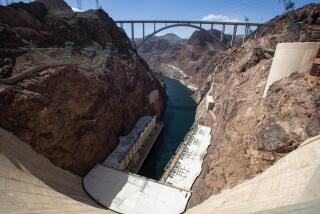Readers React: DWP doesn’t need more ratepayer money to fix pipes
To the editor: The Los Angeles Department of Water and Power and City Hall claim they have a problem finding the money to replace deteriorating water mains. They want to raise $1.3 billion to replace 435 miles of pipes over the next 10 years. (“Aging water mains a $1-billion headache for DWP,” Feb. 17)
Why haven’t they planned for these replacements over the last 50 years? Every major business has capital replacement plans built into its rate structure.
Furthermore, how can the DWP send “surplus” funds to the city’s general fund each year if it has these kinds of capital replacement requirements? Seems to me the “surplus” is not really a surplus.
Considering that water rates have increased by about a third over the last two years and the DWP has some of the highest-paid utility workers in the country, I find it hard to believe the money to fix water mains cannot be found within the existing rate structure.
Jim Toomey, Reseda
..
To the editor: The headline is too dramatic. The water main problem is really about a $10 problem.
Increase the monthly bill by this amount, and you have the money you need to replace the water mains over the next 15 years ($1.3 billion divided by about 679,000 customers, divided by 15 years, divided by 12 months). There are more than twice as many housing units as customers, so per housing unit it is a $5 problem, and if you base the fee on water usage many customers would pay less and the big users would pay more.
This hardly looks like a big problem to me.
Pieter Vandenberg, El Cajon, Calif.
..
To the editor: The article fails to make any mention of the “elephant in the room” — how real estate development is increasing population density in many areas of L.A. that have the oldest and most decayed water pipes, putting greater stress on an infrastructure that can’t tolerate any more.
The city continues to approve huge new construction projects that increase population density (and traffic) in already crowded urban areas without requiring developers to pay for the necessary improvements in infrastructure, and all during a drought.
The apocalyptic vision of an Earth that has run out of water and a population that must relocate to another planet for its salvation, as depicted in the film “Interstellar,” doesn’t seem so far-fetched when thinking of L.A.’s future if development and the corresponding increase in population remain unchecked and if our failing infrastructure is not replaced very soon.
Susan Gans, Los Angeles
Follow the Opinion section on Twitter @latimesopinion and Facebook
More to Read
A cure for the common opinion
Get thought-provoking perspectives with our weekly newsletter.
You may occasionally receive promotional content from the Los Angeles Times.






